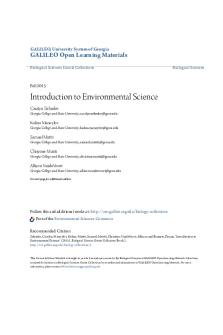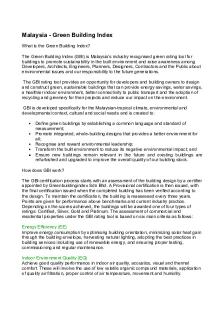ENS-112 Environmental Science Chapter 1 PDF

| Title | ENS-112 Environmental Science Chapter 1 |
|---|---|
| Course | Environmental Science |
| Institution | The University of Tampa |
| Pages | 7 |
| File Size | 93.3 KB |
| File Type | |
| Total Downloads | 17 |
| Total Views | 159 |
Summary
Chapter 1 notes from Dr. Adrienne George's lectures for ENS-112 Environmental Science at The University of Tampa...
Description
Environmental Science 112 FALL SEMESTER 2018 INSTRUCTOR: DR. Adrienne George [email protected]
Chapter 1: Science and Sustainability Our Island, Earth ● The environment consists of all the living and nonliving things around us ● Environmental Science is the study of how the natural world works, how the environment affects us, and how we affect it.
We Rely on Natural Resources ● Natural resources are the substances and energy sources that we take from the environment and rely upon to survive ● Renewable natural resources are replenished over short periods ○ Inexhaustible: sunlight, wind, and wave energy are perpetually renewed ○ Exhaustible: Timber, water, animal populations, and fertile soil take months to years to replenish ● Nonrenewable natural resources are formed much more slowly than we use them and are no longer available once depleted
We Rely on Ecosystem Services ● The environment also provides ecosystem services, such as air and water purification, cycling of nutrients, climate regulation, pollination, and waste recycling.
Population growth amplifies our impact ● The human population has grown exponentially following: ○ Agricultural Revolution (10,000 years ago) ■ Grow crops and domesticate animals leads to more food which means the ability to sustain more people
1
○ Industrial Revolution (mid 1700’s) ■ Shifted life toward an urban society powered by fossil fuels ■ Significant advances with medicine helps people live longer
Resource Consumption exerts social and environmental pressures ● Ecological footprint: the cumulative area of land and water needed to provide resources and waste disposal for a typical person ○ Carbon (60%), Cropland (19%), Forest (10%), Pasture (6%), Fishing grounds (3%), Built-up Land (2%) ● Humans are using renewable resources 68% faster than they are being replenished ○ This is called Overshoot, because we are surpassing Earth’s capacity to sustainably support our population.
Conserving natural capital is like maintaining a bank account ● The Earth’s natural capital, its store of resources and ecosystems services, is like a bank account ○ If you leave the principal intact and only spend the interest, the account remains full ○ If you deplete the principal, the account will be drawn down until it is exhausted. ● Currently, we are drawing down Earth’s natural capital, a practice that is unsustainable.
The Nature of Environmental Science ● ES is interdisciplinary, multiple disciplines together ○ Both natural studies, which focus on how the natural world works, and social sciences, which address human interactions and institutions ● Environmental Studies emphasize the social sciences.
Environmental science VS. Environmentalism ● Environmental science involves the scientific study of the environment and our 2
interactions with it ● Environmentalism is a social movement dedicated….
The Nature of Science ● Science is a systematic process for learning about the worls and testing our understand about it ○ Science may also refer to the accumulated body of knowledge that arises from observing. Questioning, testing and discovery ● Descriptive Science involves researching organisms, materials, and systems that are new or not well-known. ○ Baseline information ● Hypothesis-Driven Science uses experiments to test hypotheses as part of the scientific method
Scientific method is a traditional approach to research ● The scientific method is a formalized technique for testing ideas ● First, the scientist observes some phenomenon ● A question arises from the observation, which the scientist them attempts to explain with a hypothesis ● The scientist makes predictions, which can be directly and unequivocally tested by an experiment ● Experiments have two variables ○ The Independent Variable is the condition that changes and is to be tested ○ The Dependent Variable is the resulting condition that depends on the independent variable ● In a controlled experiment, only the independent variable is changed. ○ The treatment part of the experiment receives the change ○ The control does not receive the change and serves as a point of comparison ● Scientists record data, or information, from their studies.
3
○ Quantitative data, expressed in numbers, are especially valued because numbers are easy to compare. ● An experiment may disprove or fail to disprove a hypothesis, but it never proves it to be true. ○ If enough evidence accumulates to support the hypothesis, the scientists may eventually conclude that it is well-supported.
We test hypotheses in different ways ● In manipulative experiments, the researcher actively chooses and manipulative the independent variable ○ These are not always possible, such as in the case of global climate change ● Natural experiments compare how different variable are expressed in naturally occurring, but different, contexts ○ The independent variable varies naturally, and scientists search for correlation
Scientists use graphs to represent data visually ● Graphs help to make patterns and trends in data ○ Line graphs show trends in a variable over time ■ Multiple lines can be used to show control and treated groups in an experiment ○ Bar Graphs compare single measurements between groups, such as average algae surface coverage ○ Scatter Plots reveal any correlations between two variables. ○ Pie Charts show percentage breakdowns of a measurement, such as algae species
The scientific process continues beyond the scientific method ● When a researcher’s work is complete, it is submitted to a journal. ○ The journals editor asks several scientists to peer review the work, meaning they provide comments and criticism and judge whether it merits publication
4
● Further peer review takes place as scientists apply for grants and funding and present their research at conference presentations. ○ Other scientists may attempt to repeat the experiment ● If a hypothesis survives repeated testing and consistently predicts experimental outcomes accurately, it may be incorporated into a theory ● A Theory is widely-accepted, well-tested explanation of one or more cause-andeffect relationships that have been extensively validated by a great amount of testing
Science undergoes paradigm shift ● Periodically, science will undergo shifts where one paradigm or dominant view is replaced by another
Environmental ethics ● Ethics is a branch of philosophy that studies how people decide what is good and bad, right and wrong ● Ethical standards are criteria that help make this distinction ○ Categorical imperative advises us to treat others as we would prefer to be treated ourselves ○ Principle of Utility hold that something is right when it produces the greatest practical benefit for the most people ● Relativists believe that ethics vary with social context, while Universalists believe ethics are consistent across all cultures and contexts ● The application of ethical standards to the relationships between humans and nonhuman entities is environmental ethics ○ Is the present generation obliged to conserve resources ○ Can we justify some communities being more polluted than others ○ Are humans justified driving some species to extinction ● Answers to these questions depend on: ○ The ethical standards adopted by a person
5
○ The breadth of the person’s domain of ethical concern ● Domains of concern in relation to the natural world are divided into three ethical perspectives ○ Anthropocentrism: human-centered view that evaluates costs and benefits of actions solely on their impact on people ○ Biocentrism: describes inherent value to both human and nonhuman life ○ Ecocentrism: judges actions based on their effects on ecological systems, which contain both living and nonliving organisms
Conservation and preservation arose in the 20th century ● John Muir promote a preservation ethic, believing that the environment should be protected in a pristine, unaltered state (Sierra Club) ○ Worked with Theodore Roosevelt to increase protected areas ● Gifford Pinchot promoted the conservation ethic, which holds that people should put natural resources to use, but have …..
Environmental justice seeks fair treatment for all people ● Environmental justice involves the fair and equitable treatment of all people with respect to the environmental policy and practice, regardless of income, race, or ethnicity ○ Poor people and ethnic minorities tend to be exposed to more pollution, hazards, and environmental degradation than wealthier people ● Sustainability: is a guiding principle of modern environmental science and a concept you will encounter throughout this course
Pollution and consumption drive environmental impact ● The environment impact of humans has grown due to a combination of human population growth and the excessive consumption of resources ○ About 200,000 people are added to the planet daily ○ The 20 wealthiest nations have over 55 times more income per capita than the 20 poorest countries
6
Energy choices will shape our future ● Our reliance on fossil fuels is one of the best examples of how our resource consumption amplifies our environmental impact ○ Fossil fuels have allowed us to ■ Power machinery of the industrial revolution ■ Increase crop yields ■ Run vehicles and ■ Distribute consumer goods ○ They are nonrenewable and we must look for other options
Sustainable solutions ahead ● There are many solution to environmental problems that have arisen because of our consumption ○ Renewable energy sources are replacing fossil fuels ○ Soil conservation, high-efficiency irrigation, and organic agriculture are making food production more sustainable ○ Our technology is becoming more efficient
Students are promoting solutions on campus ● Proponents of campus sustainability seek ways to help colleges and universities reduce their ecological footprints through recycling programs, native plant restoration, organic gardening, and the development of greener buildings
Environmental Science Prepares You for the Future ● With fewer than half of the students at most schools taking any kind of environmental science course, many students are lacking environmental literacy
7...
Similar Free PDFs

Environmental Science Module 1
- 4 Pages

Environmental Science
- 16 Pages

Environmental Science and Engineering
- 109 Pages

Environmental Science Midterm Review
- 17 Pages

Environmental Science Questions
- 52 Pages

Environmental Science Review Sheet
- 19 Pages

Environmental Science Lecture notes
- 25 Pages
Popular Institutions
- Tinajero National High School - Annex
- Politeknik Caltex Riau
- Yokohama City University
- SGT University
- University of Al-Qadisiyah
- Divine Word College of Vigan
- Techniek College Rotterdam
- Universidade de Santiago
- Universiti Teknologi MARA Cawangan Johor Kampus Pasir Gudang
- Poltekkes Kemenkes Yogyakarta
- Baguio City National High School
- Colegio san marcos
- preparatoria uno
- Centro de Bachillerato Tecnológico Industrial y de Servicios No. 107
- Dalian Maritime University
- Quang Trung Secondary School
- Colegio Tecnológico en Informática
- Corporación Regional de Educación Superior
- Grupo CEDVA
- Dar Al Uloom University
- Centro de Estudios Preuniversitarios de la Universidad Nacional de Ingeniería
- 上智大学
- Aakash International School, Nuna Majara
- San Felipe Neri Catholic School
- Kang Chiao International School - New Taipei City
- Misamis Occidental National High School
- Institución Educativa Escuela Normal Juan Ladrilleros
- Kolehiyo ng Pantukan
- Batanes State College
- Instituto Continental
- Sekolah Menengah Kejuruan Kesehatan Kaltara (Tarakan)
- Colegio de La Inmaculada Concepcion - Cebu








